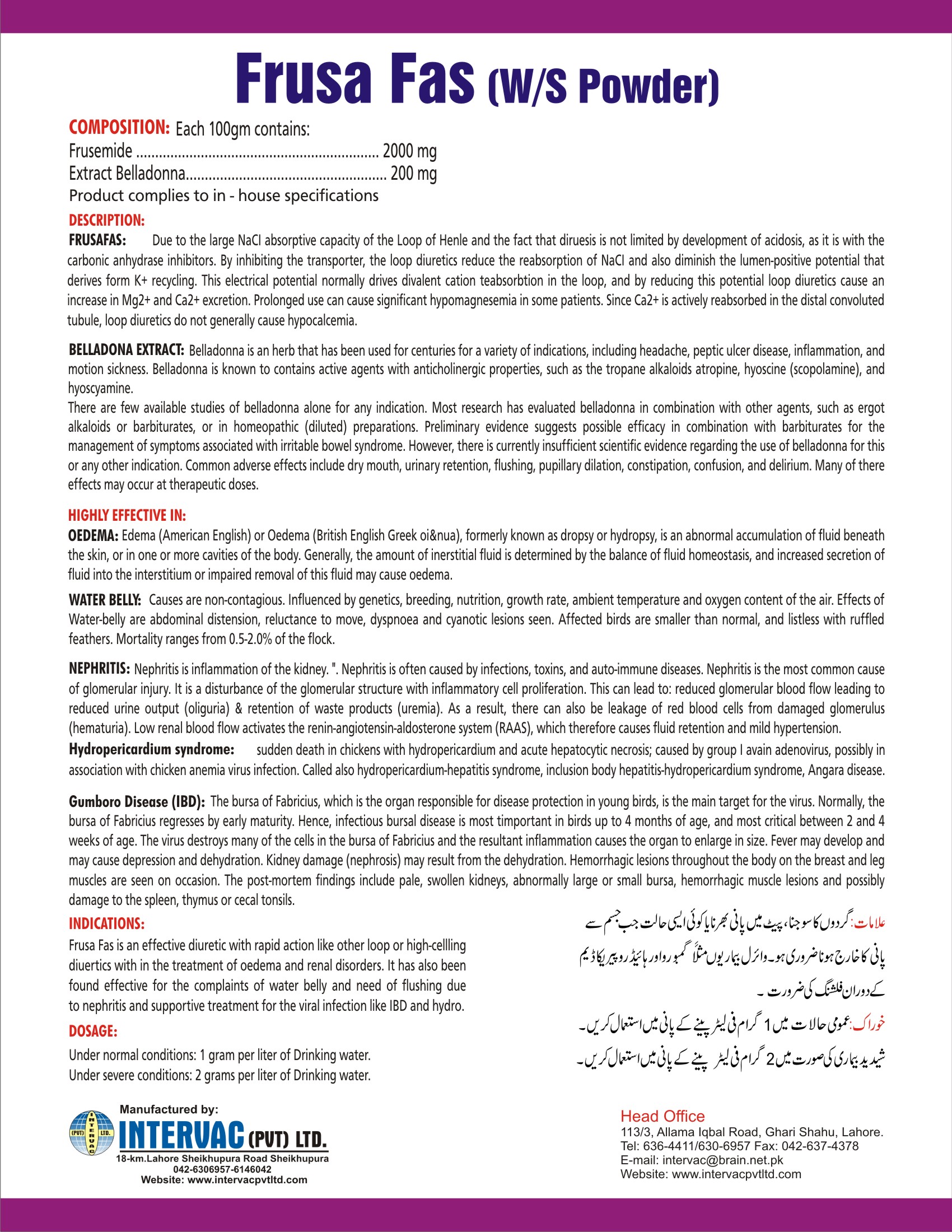Frusa Fas
(W S Powder)
COMPOSITION:
Each l00gm contains:
Frusemide………………………………….2000 mg
Extract Belladonna……………………….200 mg
Product complies to in – house specifications
DESCRIPTION:
FRUSAFAS: Due to the large NaCl absorptive capacity of the Loop of Henle and the fact that diruesis is not limited by development of acidosis, as it is with the carbonic anhydrase inhibitors. By inhibiting the transporter, the loop diuretics reduce the reabsorption of NaCl and also diminish the lumen-positive potential that derives form K+ recycling. This electrical potential normally drives divalent cation teabsorbtion in the loop, and by reducing this potential loop diuretics cause an increase in Mg2+ and Ca2+ excretion. Prolonged use can cause significant hypomagnesemia in some patients. Since Ca2+ is actively reabsorbed in the distal convoluted tubule, loop diuretics do not generally cause hypocalcemia.
BELLADONA EXTRACT: Belladonna is an herb that has been used for centuries for a variety of indications, including headache, peptic ulcer disease, inflammation, and motion sickness. Belladonna is known to contains active agents with anticholinergic properties, such as the tropane alkaloids atropine, hyoscine (scopolamine), and hyoscyamine.
There are few available studies of belladonna alone for any indication. Most research has evaluated belladonna in combination with other agents, such as ergot alkaloids or barbiturates, or in homeopathic (diluted) preparations. Preliminary evidence suggests possible efficacy in combination with barbiturates for the management of symptoms associated with irritable bowel syndrome. However, there is currently insufficient scientific evidence regarding the use of belladonna for this or any other indication. Common adverse effects include dry mouth, urinary retention, flushing, pupillary dilation, constipation, confusion, and delirium. Many of there effects may occur at therapeutic doses.
HIGHLY EFFECTIVE IN:
OEDEMA: Edema (American English) or Oedema (British English Greek oi&nua), formerly known as dropsy or hydropsy, is an abnormal accumulation of fluid beneath the skin, or in one or more cavities of the body. Generally, the amount of inerstitial fluid is determined by the balance of fluid homeostasis, and increased secretion of fluid into the interstitium or impaired removal of this fluid may cause oedema.
WATER BELLE Causes are non-contagious. Influenced by genetics, breeding, nutrition, growth rate, ambient temperature and oxygen content of the air. Effects of Water-belly are abdominal distension, reluctance to move, dyspnoea and cyanotic lesions seen. Affected birds are smaller than normal, and listless with ruffled feathers. Mortality ranges from 052.0% of the flock.
NEPHRITIS: Nephritis is inflammation of the kidney. “. Nephritis is often caused by infections, toxins, and auto-immune diseases. Nephritis is the most common cause of glomerular injury. It is a disturbance of the glomerular structure with inflammatory cell proliferation. This can lead to: reduced glomerular blood flow leading to reduced urine output (oliguria) & retention of waste products (uremia). As a result, there can also be leakage of red blood cells from damaged glomerulus (hematuria). Low renal blood flow activates the renin-angiotensin-aldosterone system (RAAS), which therefore causes fluid retention and mild hypertension.
Hydropericardium syndrome: sudden death in chickens with hydropericardium and acute hepatocytic necrosis; caused by group I avain adenovirus, possibly in association with chicken anemia virus infection. Called also hydropericardium-hepatitis syndrome, inclusion body hepatitis-hydropericardium syndrome, Angara disease.
Gumboro Disease (IBD): The bursa of Fabricius, which is the organ responsible for disease protection in young birds, is the main target for the virus. Normally, the bursa of Fabricius regresses by early maturity. Hence, infectious bursal disease is most timportant in birds up to 4 months of age, and most critical between 2 and 4 weeks of age. The virus destroys many of the cells in the bursa of Fabricius and the resultant inflammation causes the organ to enlarge in size. Fever may develop and may cause depression and dehydration. Kidney damage (nephrosis) may result from the dehydration. Hemorrhagic lesions throughout the body on the breast and leg muscles are seen on occasion. The post-mortem findings include pale, swollen kidneys, abnormally large or small bursa, hemorrhagic muscle lesions and possibly damage to the spleen,thymus or cecal tonsils.
INDICATIONS:
Frusa Fas is an effective diuretic with rapid action like other loop or high-cellling,diuertics with in the treatment of oedema and renal disorders. It has also been found effective for the complaints of water belly and need of flushing due to nephritis and supportive treatment for the viral infection like IBD and hydro.
DOSAGE:
Under normal conditions: 1 gram per liter of Drinking water.
Under severe conditions: 2 grams per liter of Drinking water.
STORAGE:
Store and temperature below 3o°c.
Keep away from reach of children
PACKING:
100gm, 200gm, 400gm, 500gm, 1000gm






There are no reviews yet.